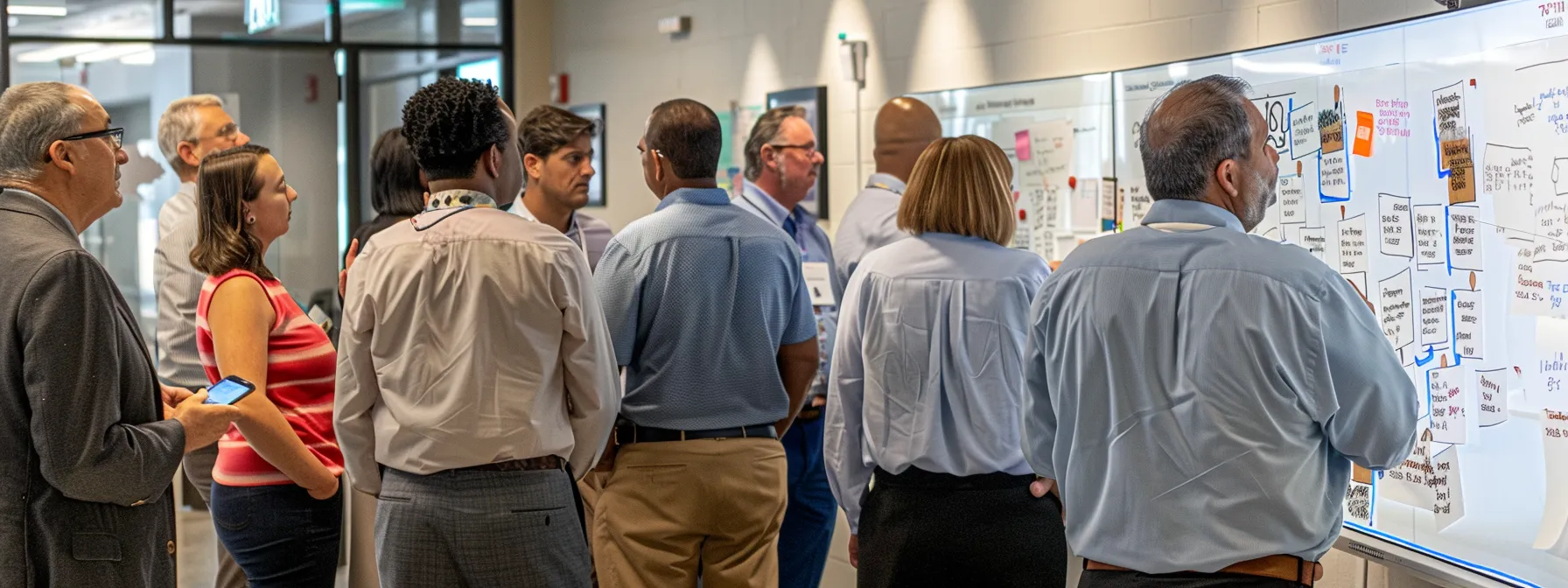Disclaimer: We sometimes use affiliate links in our content. For more information, visit our Disclaimer Page.
Organizational change often presents challenges, particularly during mergers and acquisitions when productivity falters and culture change becomes necessary. This blog post outlines guiding principles for leading successful organizational change, focusing on the importance of developing a clear vision, engaging stakeholders, and implementing effective change methodologies. By following these principles, you will learn how to foster a culture of ethics and continuous improvement, helping your organization navigate transitions smoothly and enhance overall performance. If you’re struggling with change management, this guide aims to provide practical solutions to overcome those obstacles.
Understanding the Need for Organizational Change

Understanding the need for organizational change involves identifying the driving forces behind change, assessing organizational readiness, and recognizing barriers to change. By focusing on leadership development and organizational leadership, you can better prepare for leading organizational change. Each of these areas presents specific challenges and skill requirements that are crucial for effective change management.
Identifying Driving Forces Behind Change
Identifying the driving forces behind organizational change is essential for creating a culture of innovation. You need to examine both internal and external factors that influence the need for change, such as market trends, technological advancements, and shifting customer demands. Understanding these forces allows you to assess risks associated with maintaining the status quo and to build a robust framework that incorporates human resources effectively to support these transformations.
Additionally, utilizing simulation techniques can help you visualize the potential impacts of change within your organization. By modeling different scenarios, you can better prepare for challenges that may arise during the implementation process. This proactive approach not only enhances your system’s resilience but also empowers your team to adapt swiftly, ensuring that everyone is aligned with the overall vision for the future.
Assessing Organizational Readiness
Assessing organizational readiness is crucial for successful change implementation. You need to evaluate the current culture, employee attitudes, and the overall climate within your organization. By using analytics, you can identify areas of strength and weakness, allowing you to address potential fear and uncertainty among employees. This data-driven approach enhances your confidence in moving forward with the planned changes.
As you assess readiness, consider conducting surveys or interviews to gather insights from your team. Engaging employees in this way helps reduce resistance to change and encourages open dialogue. By understanding their concerns, you can develop targeted strategies to overcome barriers and foster a supportive environment, which is vital for leading effective organizational change.
Recognizing Barriers to Change
Recognizing barriers to change requires a clear understanding of your organization’s culture and the dynamics within it. You might find that employees resist changes due to fear or uncertainty about how those changes will impact their roles. Engaging in open dialogue with your team can help clarify these concerns, fostering a culture of negotiation where feedback is encouraged. This approach not only enhances trust but also equips you with insights to develop a strategy that addresses specific challenges your organization may face.
As you navigate this process, consider seeking input from subject matter experts, such as a professor in organizational behavior, who can offer evidence-based strategies for overcoming resistance. By acknowledging the fears and concerns of your workforce, you create an environment where change becomes a collective effort. This shift can empower your team, allowing them to view challenges as opportunities for growth and transformation.
Change is necessary, but it needs a guide. A clear vision and strategy will light the way forward.
Developing a Clear Vision and Strategy

Developing a Clear Vision and Strategy
Defining clear objectives and goals is essential for effective organizational change. You will explore how aligning initiatives with your organization’s values fosters a sense of psychological safety among employees. Additionally, effective communication of the vision enhances understanding and supports problem-solving, engaging everyone in the change process. These elements are critical for achieving successful outcomes during transitions.
Defining Objectives and Goals
Defining objectives and goals sets the foundation for your transformation initiatives. By clearly articulating what you aim to achieve, you align your employees’ mindset with the organization’s vision. This alignment helps to ensure that all stakeholders understand their roles in the change process and are motivated to actively participate in achieving these goals.
Moreover, incorporating training programs tailored to these objectives can significantly enhance employee engagement. When employees receive the necessary support to navigate the changes, they are more likely to embrace the transformation initiatives. This approach not only builds confidence among your staff but also reinforces a collective commitment to the organization’s success.
Aligning Initiatives With Organizational Values
Aligning your initiatives with your organization’s values is key to fostering a culture that supports successful change management. When you design programs that reflect your values, such as sustainability or ethical leadership, employees feel a stronger connection to their work. This alignment not only boosts morale but also promotes engagement, as team members can see how their efforts contribute to the broader mission and policy of the organization.
As you lead change management initiatives, ensure these programs are integrated into your organizational framework. Consider how your leadership can articulate the importance of values in guiding actions and decisions. By establishing a clear connection between daily operations and your core values, you enable your team to navigate challenges effectively while staying true to your organizational principles.
Communicating the Vision Effectively
Communicating the vision effectively is key to addressing the complexity that often accompanies organizational change. You need to capture your employees’ attention by clearly articulating the reasons for the change and how it aligns with your organization’s goals. Research shows that when employees understand the vision and feel connected to it, they are more likely to engage fully and contribute positively to the transition process.
As a leader, consider using a consultant or expert to help frame the vision in a way that resonates with your team. This support can include developing targeted messages that highlight the importance of talent management throughout the change. By ensuring that everyone understands their role in the vision, you create a cohesive environment where team members feel valued and motivated to embrace the forthcoming changes.
A clear vision needs support to thrive. Engaging and empowering stakeholders will bring that vision to life.
Engaging and Empowering Stakeholders

Engaging and empowering stakeholders is critical for successful organizational change. Involving leadership and management teams ensures alignment on goals and behavior. Encouraging employee participation and feedback creates a sense of ownership, while addressing concerns builds necessary support. These strategies enhance resource allocation and improve customer satisfaction, increasing the odds of a successful program implementation.
Involving Leadership and Management Teams
Involving leadership and management teams in organizational change is essential for fostering a culture of ownership and accountability. When leaders, including the chief human resources officer, are actively engaged in the change process, they model the emotional intelligence necessary to navigate challenges effectively. Their involvement not only provides clear direction but also minimizes the risk of failure by ensuring that all levels of the organization understand the importance of the initiative and their respective roles in its success.
Effective communication is a key aspect of involving these teams in the change effort. By facilitating open dialogue among leadership, you can encourage them to share insights based on their experiences with organizational behavior. This collaboration allows for the identification of potential barriers and the development of strategies to address them, ultimately empowering everyone involved to contribute to a smoother transition and reinforce the overall commitment to change.
Encouraging Employee Participation and Feedback
Encouraging employee participation and feedback is vital for strengthening organizational culture during times of change. When you actively seek input from your team, it fosters an environment where individuals feel valued and heard. This approach not only improves morale but also enhances knowledge sharing, which can lead to innovative solutions that drive organization development. For instance, holding regular forums or feedback sessions can create a platform for open discussions that help identify potential issues and conflict management strategies early on.
As a leader, your willingness to embrace feedback can significantly influence the change process. By showcasing leadership experience examples for resumes that include participatory initiatives, you demonstrate your commitment to inclusive change. This not only builds trust within your workforce but also empowers employees to take ownership of their roles in the transformation. By valuing their input, you cultivate a culture of collaboration that is essential for navigating the challenges of organizational change successfully.
Addressing Concerns and Building Support
Addressing concerns among your team is essential for building support during organizational change. You need to create an open environment where employees feel comfortable voicing their worries. Regular check-ins and feedback sessions can be valuable tools to assess their feelings, allowing you to tailor your approach and provide reassurance effectively.
Building support requires not just acknowledging concerns, but actively engaging employees in the change process. You can achieve this by presenting clear, honest communication about the changes and their benefits. Sharing success stories from similar transitions within your industry can inspire confidence and demonstrate that change can lead to positive outcomes, ultimately fostering a sense of ownership among your workforce.
With stakeholders engaged, the path forward becomes clearer. Now, it’s time to turn that shared energy into action through effective change methodologies.
Implementing Effective Change Methodologies

Implementing effective change methodologies is vital for guiding successful organizational change. You should start by selecting appropriate change management models that fit your organization’s needs. Establishing milestones and timelines will help you measure progress and keep your team focused. Finally, integrating changes into existing processes ensures a smoother transition, ultimately driving positive outcomes for your organization.
Selecting Appropriate Change Management Models
Selecting the right change management model is crucial for ensuring successful organizational change. You should evaluate options like Kotter’s 8-Step Process, Lewin’s Change Management Model, or the ADKAR model to determine which aligns best with your organization’s culture and objectives. Each model has specific steps that help guide you through the change process, making it easier to manage transitions and engage stakeholders effectively.
When you choose a change management model, consider the unique challenges your organization faces and your team’s readiness for change. For instance, if your team struggles with communication, a model that emphasizes stakeholder engagement may be more beneficial. Implementing a tailored approach based on these assessments will increase your chances of successfully guiding your organization through change while addressing potential pain points along the way.
Establishing Milestones and Timelines
Establishing milestones and timelines is essential for effective organizational change management. By setting clear milestones, you can create a roadmap that allows your team to track progress and stay motivated throughout the process. This structured approach not only clarifies expectations but also facilitates communication about changes, making sure everyone understands how their contributions align with the overall objectives.
As you implement change, consider utilizing project management tools to visualize timelines and track milestones. This not only helps maintain accountability but also allows for timely adjustments if challenges arise. By fostering a proactive environment where milestones serve as indicators of success, you encourage a culture of continuous improvement and support your team in navigating the complexities of organizational change with confidence.
Integrating Changes Into Existing Processes
Integrating changes into existing processes is essential for a seamless transition during organizational change. You need to ensure that new initiatives align with current workflows and systems to minimize disruptions. For instance, if you are implementing a new software tool, take the time to provide training sessions that help employees understand how to merge this tool with their daily tasks, which enhances productivity and eases the transition.
To achieve this integration effectively, engage key stakeholders early in the process. By gathering insights from different teams, you can identify specific areas where changes might create friction. This collaborative approach not only helps tailor the implementation strategy but also fosters a sense of ownership among team members, ultimately supporting a smoother adoption of the changes you aim to achieve.
Change must be followed by action. As you consider your next steps, the real task lies in sustaining momentum and evaluating progress.
Sustaining Momentum and Evaluating Progress

Monitoring Key Performance Indicators (KPIs) is essential for measuring the success of your organizational change. Recognizing achievements and efforts will motivate your team, while adjusting strategies based on feedback ensures continuous improvement. These practices are crucial for maintaining momentum and fostering a culture that embraces change at all levels of your organization.
Monitoring Key Performance Indicators
Monitoring Key Performance Indicators (KPIs) is essential for assessing the effectiveness of your organizational change initiatives. By regularly tracking metrics that align with your strategic goals, you gain valuable insights into how well your changes are performing. For example, if you implement a new sales strategy, monitoring KPIs such as customer acquisition rates or sales growth can guide your decision-making process and help you identify areas that need improvement.
Establishing a robust system for KPI monitoring enables you to respond quickly to any negative trends or challenges that may arise during the change process. Effective communication of these results to your team fosters accountability and keeps everyone focused on shared objectives. Engaging employees in this evaluation process not only boosts morale but also encourages a culture of continuous improvement, ensuring that your organizational change remains on track and delivers the desired outcomes.
Recognizing Achievements and Efforts
Recognizing achievements and efforts during organizational change plays a pivotal role in maintaining momentum. When you celebrate both small and large successes, you boost team morale and reinforce the commitment to change initiatives. For example, acknowledging project milestones publicly can motivate your staff, providing a sense of accomplishment that encourages continued engagement and dedication to the overall objectives.
Additionally, incorporating regular feedback sessions where you highlight individual contributions can enhance your organization’s culture of appreciation. This practice not only fosters a supportive environment but also allows team members to feel valued for their roles in the change process. By establishing a routine of recognition, you effectively strengthen the team’s resolve to overcome challenges and drive the transformation forward.
Adjusting Strategies Based on Feedback
Adjusting strategies based on feedback is crucial for ensuring the success of organizational change initiatives. As you gather insights from your team, listen closely to their suggestions and concerns. This not only demonstrates your commitment to collaboration but also allows you to modify plans that may not align with actual experiences, enhancing the overall effectiveness of your change efforts.
In practice, you might implement regular feedback loops through surveys or informal check-ins. By actively engaging your employees in this manner, you can identify areas needing adjustment and foster a sense of ownership in the change process. This approach can motivate your team, ensuring they remain invested in achieving the organization’s goals while also paving the way for continuous improvement.
Keeping momentum is just the beginning. To truly thrive, you must nurture a culture that embraces improvement at every turn.
Fostering a Culture of Continuous Improvement

Leading by example at all levels is crucial for fostering a culture of continuous improvement. Encouraging innovation and learning within your organization empowers employees to embrace change and seek new solutions. By embedding change into the organizational culture, you create an environment where growth is a shared responsibility, enhancing your team’s effectiveness in navigating transformations.
Leading by Example at All Levels
Leading by example is a powerful way to foster a culture of continuous improvement within your organization. As a leader, when you actively embrace change and demonstrate a commitment to ongoing learning, you signal to your team that this mindset is essential for success. Share your own experiences with change and highlight the lessons you’ve learned along the way, showing your team that growth is a journey that everyone can participate in.
Encouraging open communication about challenges and successes can further enhance this culture. By modeling vulnerability and openness, you create an environment where team members feel safe to express their thoughts and ideas. This approach not only builds trust but also encourages innovation, as employees are more likely to contribute solutions when they see their leadership engaging in the same practices of improvement and adaptation.
Encouraging Innovation and Learning
Encouraging innovation and learning within your organization is key to fostering a culture of continuous improvement. You can create an environment where employees feel empowered to share their ideas by promoting collaboration and open dialogue. For example, implementing regular brainstorming sessions allows team members to contribute their insights and experiences, leading to creative solutions that drive successful organizational change.
Additionally, providing opportunities for professional development through workshops or training can boost employees’ confidence and enhance their skills. When you invest in your team’s growth, you not only improve individual performance but also cultivate a proactive approach to challenges. This commitment to innovation not only enhances overall productivity but also reinforces your organization’s ability to adapt, ensuring that everyone is aligned and engaged in the change process.
Embedding Change Into Organizational Culture
Embedding change into organizational culture is essential for fostering a continuous improvement mindset within your team. By integrating change as a core value, you help employees understand that adaptation and innovation are expected and supported. For example, actively promoting feedback loops and encouraging team members to suggest improvements creates an inclusive atmosphere where everyone feels invested in the organization’s success.
To effectively embed change into your culture, communicate openly about its importance and align it with your organization’s mission and goals. Providing training and resources helps your team develop the skills needed to embrace change confidently. This not only equips employees to navigate new challenges but also cultivates a culture where collaboration and support become natural responses to shifts in the business landscape, ultimately driving sustained progress and growth.
Conclusion
Successful organizational change relies on clear guiding principles that encompass understanding driving forces, assessing readiness, and involving stakeholders. By establishing a shared vision and aligning initiatives with organizational values, leaders can foster a culture of engagement and accountability. Regularly monitoring progress and recognizing achievements strengthens commitment and motivates teams during transitions. Ultimately, crafting a culture of continuous improvement empowers organizations to adapt and thrive in an ever-changing environment.





